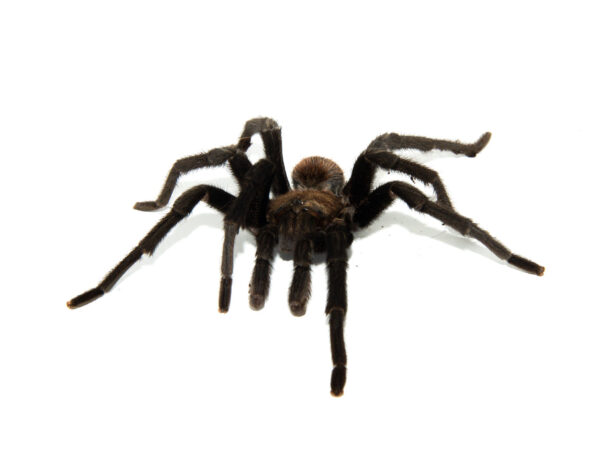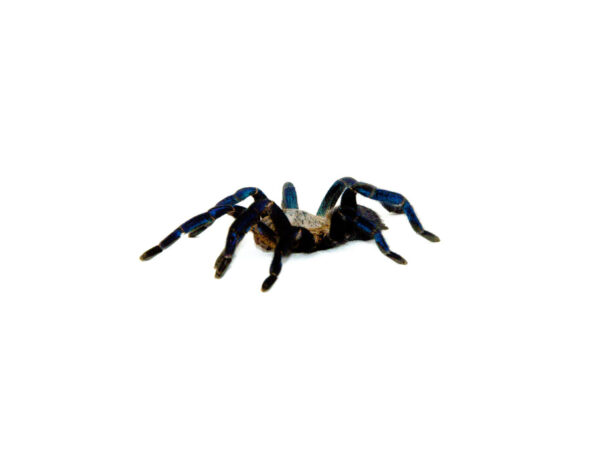- “skeleton leg tarantula (ephebopus murinus)” already exists in your wishlist
Skeleton Leg Tarantula (Ephebopus murinus): A Stunning and Unique Arboreal Burrower
The Skeleton Leg Tarantula (Ephebopus murinus) is a striking species beloved for its bold appearance and fascinating behavior. Hailing from the tropical rainforests of northern South America, this tarantula captivates hobbyists with its high-contrast black and white leg markings, which resemble a skeletal pattern—hence the name.
Despite its spooky name, the Skeleton Leg Tarantula is a beautiful and intelligent creature that thrives in captivity when given proper care. It’s ideal for intermediate to advanced hobbyists due to its speed and defensive nature.
Appearance and Size
The most notable feature of the Skeleton Leg Tarantula (Ephebopus murinus) is the brilliant skeletal striping on the front legs. These white bands contrast sharply against the velvety black background, giving it a one-of-a-kind look.
-
Size: Adults can grow up to 5–6 inches in leg span.
-
Coloration: The body ranges from dark brown to olive with copper highlights, but the standout feature remains those striped front legs.
This combination of color and pattern makes them a visually fascinating species, especially when seen in motion.
Behavior and Temperament
While visually stunning, the Skeleton Leg Tarantula is known to be somewhat defensive. It is fast, skittish, and will often retreat into its burrow when startled. If threatened further, it may adopt a threat pose or even bite—making it a species better suited to those with some tarantula-keeping experience.
Interestingly, this species displays both arboreal and fossorial behaviors. In the wild, it may climb low vegetation or create burrows beneath logs and tree roots. In captivity, it is most commonly kept as a burrower.
Habitat Setup
Creating the right environment for this species is essential to ensure its health and well-being.
Enclosure Recommendations:
-
Size: 10–15 gallon enclosure for adults
-
Substrate: Deep, moist substrate (6 inches minimum) for burrowing—coco fiber or peat moss is ideal
-
Humidity: 75–85%
-
Temperature: 75–80°F
-
Hides: Cork bark, tunnels, or starter burrows
While it may use vertical surfaces, the Skeleton Leg Tarantula (Ephebopus murinus) is primarily a terrestrial burrower in captivity. Ensure the substrate stays slightly damp but not soggy to avoid mold growth.
Feeding
This species has a healthy appetite and will eagerly take down prey.
Diet:
-
Crickets
-
Dubia roaches
-
Mealworms
-
Superworms (for adults only)
Feed juveniles 2–3 times per week and adults once a week. Always remove uneaten prey after 24 hours to maintain enclosure cleanliness.
Lifespan and Growth
The Skeleton Leg Tarantula has a moderate growth rate and a decent lifespan.
-
Females can live up to 15 years
-
Males generally live 3–4 years after maturity
They typically molt several times a year when young, slowing down in frequency as they age.
Why Choose a Skeleton Leg Tarantula?
The Skeleton Leg Tarantula (Ephebopus murinus) offers a unique blend of beauty, behavior, and challenge. Its striking leg pattern makes it one of the most instantly recognizable species in the tarantula world. For experienced keepers looking for a new addition with both visual appeal and intriguing behavior, this species delivers.
Looking to bring home a Skeleton Leg Tarantula? Check out onestopreptileshop.com for healthy, captive-bred specimens ready for their forever homes.
Summary
The Skeleton Leg Tarantula is a must-have for any seasoned tarantula enthusiast. From its beautiful black-and-white pattern to its fascinating dual nature as both a burrower and occasional climber, this species is one of the hobby’s most underrated gems. While its defensive tendencies may not suit beginners, those with experience will find this tarantula to be a thrilling and rewarding addition to their collection.








Reviews
There are no reviews yet.